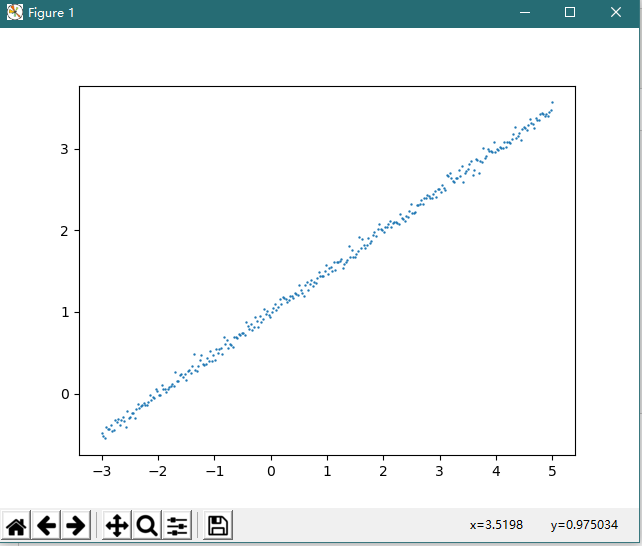1、准备环境,探索数据
import numpy as np from keras.models import Sequential from keras.layers import Dense import matplotlib.pyplot as plt # 创建数据集 rng = np.random.RandomState(27) X = np.linspace(-3, 5, 300) rng.shuffle(X) # 将数据集随机化 y = 0.5 * X + 1 + np.random.normal(0, 0.05, 300) # 假设真实模型为:y = 0.5X + 1 # 绘制数据集 plt.scatter(X, y, s=0.5) plt.show()

2、准备数据训练模型
# 划分训练集和测试集 X_train, y_train = X[:400], y[:400] X_test, y_test = X[-100:], y[-100:] # 定义模型 model = Sequential () # 用 Keras 序贯模型(Sequential)定义一个单输入单输出的模型 model model.add(Dense(output_dim=1, input_dim=1)) # 通过 add()方法一层, Dense 是全连接层,第一层需要定义输入 # 设置模型参数 model.compile(loss='mse', optimizer='sgd') # 通过compile()方法选择损失函数(均方误差)和 优化器(随机梯度下降) # 开始训练 print('Training ==========') for step in range(301): cost = model.train_on_batch(X_train, y_train) # Keras 的 train_on_batch() 函数训练模型 if step % 100 == 0: print('train cost: ', cost)

3、测试训练好的模型
print(' Testing ==========') cost = model.evaluate(X_test, y_test, batch_size=40) print('test cost:', cost) W, b = model.layers[0].get_weights() # 查看训练出的网络参数
print('Weights=', W, ' biases=', b) # 由于网络只有一层,且每次训练的输入和输出只有一个节点,因此第一层训练出 y=WX+b 的模型,其中 W,b 为训练出的参数

最终的测试 cost 为: 0.0026768923737108706
4、可视化测试结果
y_pred = model.predict(X_test) # 用测试集进行预测 plt.scatter(X_test, y_test, s=4) # 绘制测试点图 plt.plot(X_test, y_pred, lw=0.7) # 绘制回归直线 plt.show()

。。。